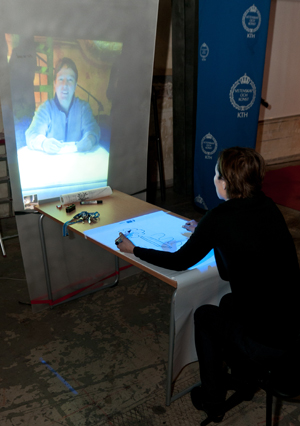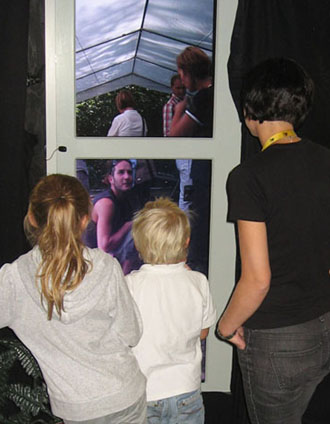Face to face – from afar
RESEARCH IN DEPTH
Advances in IT and communication services are changing the way the world looks at the built environment. “Video is a building material,” says Charlie Gullström, visiting associate professor in architecture, media, interaction and communication at the KTH Department of Architecture. “As an architect, I’m interested in extending the room using virtual doors and windows.”

Spaces today are no longer limited to the physical environment. We spend more and more of our waking hours in the virtual world, which is why many architects are working hard to integrate information technology into the buildings of the future.
“People no longer need to be physically in the same room to be able to work and spend time together,” Gullström says. “We can be in totally different places and still be ‘present’ enough to speak, talk and work with each other.”

Gullström’s design-driven research uses technology to create a sense of closeness between people who may be physically far apart.
“Video conferences are part of our future. IT-enabled virtual meetings support sustainable development by reducing expensive, energy-intensive travel. But people want to meet face-to-face, to make eye contact; it’s not enough just to see someone on a computer screen. And you also have private email and confidential work documents in your computer, so you don’t want other people ‘in there’ too.”
Gullström is working with a project team on a virtual venue for remote meetings – a space that’s not limited to a computer, and which includes real horizontal and vertical surfaces such as walls and tables.
The project, dubbed “Shared Negotiation Space,” also uses a mediated drawing board.It allows users to hold work meetings, collaborate and negotiate from separate locations, while still having eye contact and interacting in real time on a shared work space. “We’re focusing on the actual user experience,” Gullström says.
Gullström heads the ICT Lab’s Mediating Presence project, based in KTH Reactor Hall R1. The project has brought together more than 20 Presence Research specialists from KTH, Delft University of Technology in the Netherlands, Sweden’s Luleå University of Technology and Aalto University in Finland.
“This way of working creates important connections between researchers, between institutions, and between the areas of art, design and science,” Gullström says. “This is what I think work will be like in the university of the future.”

She has also been involved in creating another possible version of the collaborative space of the future: the “glass door.” A live remote-video feed gives the viewer the impression of standing on the threshold of another room and looking in … or is it out?
A virtual “glass door” installed at Stockholm’s Historical Museum in 2011 allowed visitors to interact with archeologists working at an excavation a few kilometres away, discussing findings with experts. At the distant location, guides could even kneel down and maintain eye contact while chatting with curious children watching the dig.
Eye contact is created between people on each side of the glass door by means of a glass sheet inclined at a 45-degree angle, which reflects the image from a concealed video camera placed at eye level to the side of the door.
By Katarina Ahlfort

